Researchers
Position:Home首页 > Scientific Research > Researchers

Professor Yong-Hao Lu
Keywords:Corrosion and wear
Contact:lu_yonghao@mater.ustb.edu.cn
Researches
Prof. Yonghao Lu gained his Ph. D. degree in Materials science from the Beihang University in China. He has worked as a postdoc or visitor at USTB, Tohoku University and City University of Hong Kong, and now has been professor of Materials Science and Engineering in NCMS since 2005. Prof. Yonghao Lu is the vice director and vice chief-engineer of NCMS. His professional research lies in the microstructure and service behavior of advanced metal materials in the industry field such as nuclear and thermal power plant et al. His former study also focused on the hard thin films such as TiAl, TiBN, TiCN etal. Up to now he has published more than 160 papers in international journals, such as Appl. Phys. Lett., Acta mater., Corros. Sci, Tribo. Int, Wear, J.Mater. Research, J.Nucl. Mater., J. Vac. Sci. Technol., Surf. Coat. Technol.
l Main Projects
- Project 1:Beijing Municipal Science and Technology Project (Z181100005218005), total fund 2850000 RMB, 2018-2020.
- Project 2:National Key Research and Development Plan (2016YFF0203804), total fund 2850000 RMB, 2016-2019.
- Project 3:National Energy Application Technology Research and Engineering Demonstration Project (NY20111201-1), total fund 300000 RMB, 2012-2016.
- Project 4:National Key Basic Research Program of China (973 Program) (2011CB610504), total fund 3160000 RMB, 2011-2015.
- Project 5:Important National Science & Technology Specific Projects of China (2011ZX06004-009-0302), total fund 997700 RMB, 2011-2014.
- Project 6:Important National Science & Technology Specific Projects of China (2011ZX06004-009-0603), total fund 431600 RMB, 2011-2014.
- Project 7:Guangdong Education Department's Project of Combination of Learning and Research (2011A090200096), total fund 300000 RMB, 2012-2013.
- Project 8:Study on the long life cycle pipe and anti-corrosion technology of oilfield water-bearing pipeline, total fund 450000 RMB, 2016-2018.
l Main Contributions
- The systematic studies were conducted on the fretting wear behavior of Inconel 690TT and 600 alloys in different environments (room temperature air, high temperature air, high temperature controlled oxygen content, simulated seawater,electrochemical polarization condition,high temperature and high pressure water). The fretting running characteristics, coefficient of friction and wear volume, gradient structure evolution and crack initiation and propagation in the worn subsurface induced by fretting wear were carefully analyzed. Meanwhile, the models of formation of gradient structures in different environments were also systematically established.
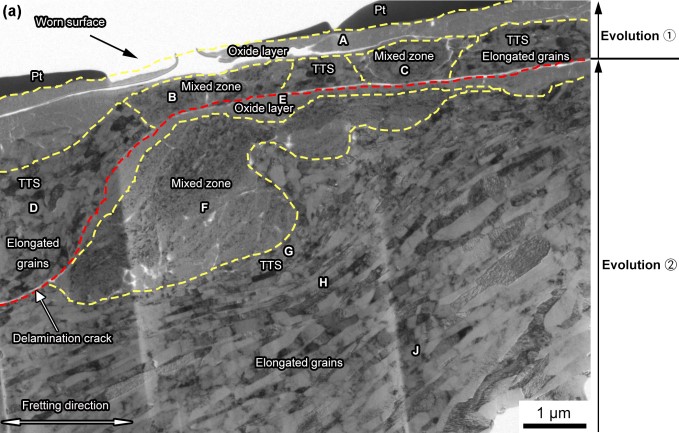
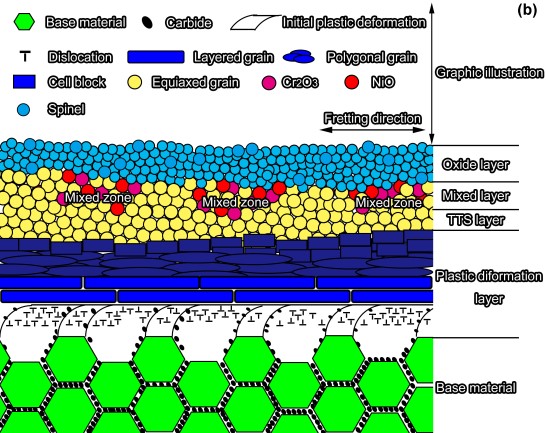
Fig. 1. (a) The low magnification cross-sectional BFTEM image of worn surface and (b) the schematic diagram of typical microstructure evolution in subsurface of worn surface in Inconel 690TT alloy.
- The relationship between microstructure oxidation behavior of the fusion boundaries of dissimilar metal welds (DMW) including A508-III/Alloy 82 and SS316L/Alloy 182 were studied. There were two alternately distributed typical fusion boundaries, one was sharp fusion boundary (named Type-A), another one was a broad boundary with an epitaxial growth structure (named Type-B). The surface potential, residual strain, electrochemical performance, hardness distribution and oxidation were related to the microstructure of DMW. The hardening phenomenon appeared in the epitaxial growth area of Type-B fusion boundary. The surface potential change between base metal and weld metal of Type-A fusion boundary was bigger than that of Type-B. Type-A fusion boundary had higher residual strain value than Type-B one. The Type-A fusion boundary will preferentially be corroded. The 316L stainless steel side of the Type-A fusion boundary act as the anode during the corrosion, this led more metal ions released. And also, in the inner layer of the 316L stainless steel of Type-A fusion boundary, there was no Cr2O3 exist. Due to the spatial particularity of octahedral structure of spinel oxide, many holes are formed between the spinel oxides.
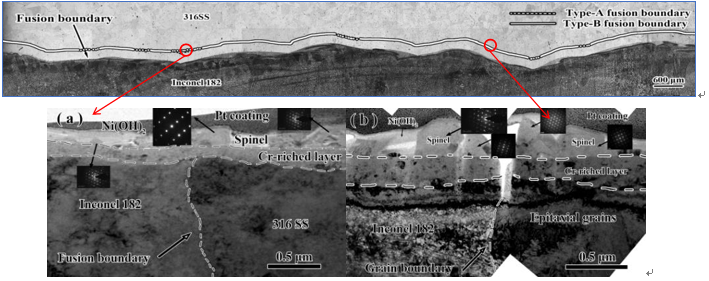
Fig. 2. Typical OM microstructure at the fusion boundary in transversal direction showing the statistical results on location distributions of the Type-A fusion boundaries without an epitaxial growth structure and Type-B one with an epitaxial growth structure. The BFTEM image of oxidation in (a) Type-A fusion boundary and (b) Type-B fusion one.
- The investigation on the microstructure, thermal aging behavior and their effects on the oxidation behavior of domestic 308L stainless steel cladding material were conducted. Austenite and worm (or island)-like ferrite phases formed in the E308L stainless steel weld overlay cladding. Higher Cr content enhanced the pitting resistance and compactness of the oxide film to reduce metal amount oxidized and dissolved. Thermal aging had no obvious effect on the volume fraction of ferrite, but could cause microstructural evolution by spinodal decomposition and G-phase precipitation in the ferrite phase. Thermal aging showed no obvious effect on the oxidation behavior of austenite phase but resulted in thickness and composition change of oxide film formed on the aged ferrite phase. G-phase and silicide phase was believed to enlarge the level of Cr-depleted, which further facilitated ions dissolution and oxidation of the aged ferrite phase during corrosion test. Through small punch test, small punch energy decreased with the increase of thermal aging time, wherein, the rapidly degradation part in the range of 0-1000 h was controlled by the spinodal decomposition, while the slow decrease part in the case of aging time longer than 1000 h was related to the formation of G-phase and silicide phase and spinodal decomposition.
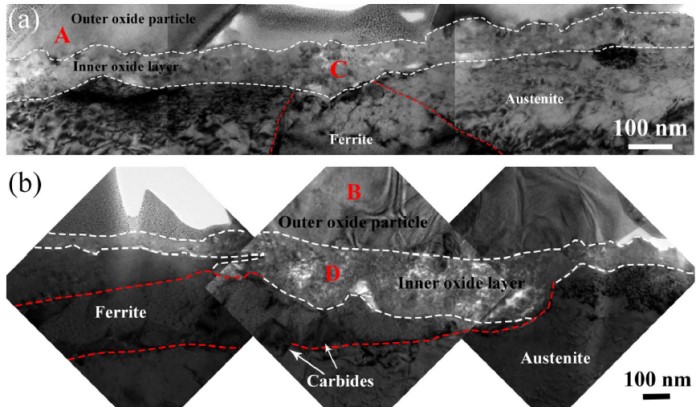
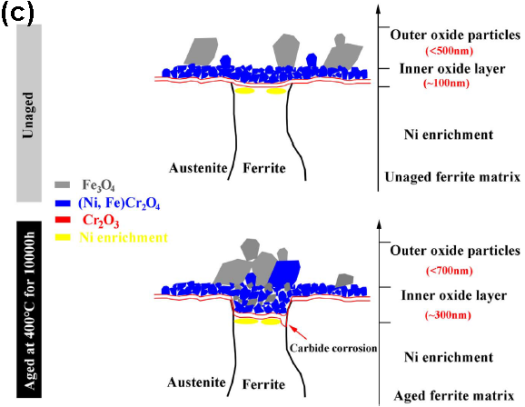
Fig. 3. TEM bright-field images of the oxide film formed on (a) the unaged sample and (b) the sample aged for 10,000 h. (c)The schematic diagram of the formation of oxides on the unaged sample and the sample aged for 10,000 h.
- The flow-induced corrosion (FAC) behavior and mechanism of the main steam trap (SA106B) were investigated. Due to the low Cr content, SA106B failed to form a stable and dense oxide film FeCr2O4, which caused serious corrosion of the material, and many small pits appeared on the surface of the material. It was easy to preferentially corrode at the interface. Under the scouring of high-temperature water, the corrosion process at the phase interface was accelerated, causing local corrosion to deteriorate. The high temperature water in the tube head is turbulent, and the erosion of the tube wall has both shear stress and normal stress. The oxide particles on the surface of the substrate are difficult to deposit and adhere, forming only a double-layer oxide film structure. The high temperature water in the tube is laminar, resulting in the only shear stress on the substrate, close to the substrate, slow flow rate, high iron ion solubility, and easy to deposit and form oxide particles attached to the surface of the substrate. The stacking of particles and the outward diffusion of iron ions in the inner layer cause the growth of the inner oxide film to grow and become dense, forming a four-layer oxide film structure, which makes the diffusion of iron ions at the interface of the substrate/oxide film difficult.
- For the outer wall of the heat transfer tube, SCC is easy to occur in the scratched area during the service in nuclear power plant. The effect of the scratch size factor on the SCC cracking tendency of the outer wall of the 690 heat transfer tube in a strong alkali solution was investigated by using a reverse U-bend sample with different size scratches. As the radius of the scratch root decreases and the depth increases, the stress concentration of the scratch root increases, and the intergranular erosion behavior of the material also gradually increases, especially when the scratch tip is microcrack due to cold working deformation, resulting in the growth of SCC crack. The effect of cold working deformation pass on the SCC cracking tendency of the inner wall of 690 tube in the simulated PWR primary environment was studied by using the reverse U-bend specimens subjected to different cold processing and bending treatments. With the increase of cold processing passes, more tiny cracks and holes and even larger fatigue cracks were generated on the inner wall of the 690 tube, which became an important factor in inducing the crack initiation and growth of the 690 tube SCC. The effects of different strain rates on the SCC behavior of the 690 heat transfer tubes were investigated by the slow strain rate testing method in the simulated PWR environments. As the strain rate decreases, the SCC cracking behavior of the 690 tube will increase significantly, and the crack growth rate will also increase.
- The hot corrosion behavior of P92/G115 martensitic heat resistant steel was studied by surface coating of sulfate. Alkaline melting at the salt film/oxide interface is the main cause of the destruction of the early protective oxide film. Na2O/K2O dissolves the oxide while sulfur is released from the sulfate into the matrix. Sulfur enters the matrix to form a loose sulfide band at the oxide/matrix interface and forms sulfide particles distributed under the sulfide band at the martensite lath boundary. As oxygen diffuses into the matrix, oxidation of the sulfide at the oxide/matrix interface causes corrosion to continue to develop in depth. The evolution law and life prediction method of P92 steel during creep process were studied by using the interrupt creep method. High temperature δ-ferrite and inclusions have a significant effect on high temperature and high stress creep properties. The rapid nucleation of creep pores around the high temperature δ-ferrite and inclusions, and the formation of cavities in the material leads to a significant reduction in creep performance.
- The long life cycle and anti-corrosion technology of oilfield water-bearing pipeline were investigated. Through the study of the corrosion behavior of organic acid in the simulated solution of the gas collector separator, the influence law and mechanism of the concentration and temperature of formic acid on the corrosion of carbon steel in the gas production fluid of gas well were studied. The hydrogen sulfide and partial pressure were discussed. The main reason for the change in the color of the gas produced by the gas well is that, as a function of environmental factors, the black FeS in the produced water was generated and brought into contact with the air to reoxidize into a brown-yellow ferric iron product, resulting in a continuous color change. The effects of groundwater level changes, sulfate-reducing bacteria and sulfate ion content changes on the corrosion behavior of buried pipelines at the pumping station were discussed, and the reasons were basically clarified. Through a large number of on-site, literature investigation and laboratory tests, the failure analysis of five pipeline corrosion perforation in Changqing Oilfield was completed. The influence of environmental factors on the corrosion influence of 20# steel was investigated. Because the corrosion behavior of the pipe before and after the inversion point was significantly different, the existing inversion model was given.
- Oxidation behavior at the tips of several stress corrosion cracking (SCC) crack, including intergranular SCC (IGSCC) and transgranular SCC (TGSCC) cracks, in heat-treated 304L stainless steel in high temperature oxygenated water was studied. The study showed that oxygen played a key role in nucleation and propagation of SCC cracks. For the IGSCC crack, oxidation took place followed by nucleation and growth of microcracks in the oxide ahead of the crack tip on the grain boundary plane. The IGSCC crack then propagated by linkage with these microcracks. Oxides formed in the high temperature water with different dissovled oxygen (DO) had different configurations and microstructures. In the case of low DO, separate oxides of Cr2O3 and Fe3O4 types were formed, while the oxide formed in high DO consisted of mixed FeCr2O4 and Fe3O4. For the TGSCC crack, oxidation along deformation bands and nucleation and growth of microcracks within oxide were important mechanisms. It was found that Si was preferentially oxidized ahead of the crack tip, promoting SCC crack propagation. Ni enrichment at some SCC crack tips was also revealed.

Fig. 4. The DFTEM image of the IGSCC crack tip in 304L stainless steel tested in low DO water.
l Publications
1. L.G. Ling, T.G. Liu, Y.H. Lu, P.L. Guo. Investigation of the oxides film on 304L base metal produced during welding process without inert gas shielding. Applied Surface Science 465 (2019) 780–786.
2. W. Wang , X.Y. Cao, X.F. Ding, Y.H. Lu, T. Shoji. TEM study on oxidation mechanism of the dissimilar welds between 316 stainless steel/Inconel 182 in high temperature and high pressure water. Materials Characterization 131 (2017) 339–347.
3. X.Y. Cao, P. Zhu, T.G. Liu, Y.H. Lu, T. Shoji. Effect of thermal aging on oxide film of stainless steel weld overlay cladding exposed to high temperature water. Materials Characterization 138 (2018) 195-207.
4. L. Xin, B.B. Yang, J. Li, Y.H. Lu, T. Shoji, Microstructural characteristics of Alloy 690TT subjected to fretting corrosion in high temperature water. Corrosion Science 123 (2017) 116-128.
5. L. Xin, B.B. Yang, Z.H. Wang, J. Li, Y.H. Lu, T. Shoji, Microstructural evolution of subsurface on Inconel 690TT alloy subjected to fretting wear at elevated temperature, Materials & Design 104 (2016) 152-161.
6. X. Y. Cao, X. F. Ding, Y. H. Lu, P. Zhu, T. Shoji. Influences of Cr content and PWHT on microstructure and oxidation behavior of stainless steel weld overlay cladding materials in high temperature water. Journal of Nuclear Materials (2015), 467: 32-41
7. Z. R. Chen, Y. H. Lu. TEM observation of martensite layer at the weld interface of an A508III to Inconel 82 dissimilar metal weld joint. Metallurgical and Materials Transactions A. (2015), 46(12): 5494-5498.
8. Y. H. Lu, and Y. G. Shen: Nanostructure transition: from solid solution Ti(N,C) to nanocomposite nc-Ti(N,C)/a-(C, CNx) . Applied Physics Letter, 90(2007)221913.
9. Y. H. Lu, Z.-J. Liu, Y.G. Shen: Investigation of nanostructure evolution and twinning of nanocrystallites in Ti-Bx-Ny nanocomposite thin films deposited by magnetron sputtering at low temperature by means of HRTEM and Monte Carlo simulation. Acta Materialia. 54(11) (2006)2897.
10. Y. H. Lu, Q. J. Peng, K. Sato and T. Shoji: An ATEM study of oxidation behavior of SCC crack tips in stainless steel 304L in high temperature oxygenated water. Journal of Nuclear Materials347 (2005) 52.
l Books
1. Y. H. Lu: Nanostructure, Phase Configuration and Mechanical Behaviors in TiN Based Nanocomposite Superhard Thin Films, in New Research on Nanocomposites (ISBN: 978-1-60456-799-1), edited by Luis M. Krause and Jonas T. Walter, Dec. 2008, Nova Science Publishers, USA.
l Patents
1. An experimental system for loading pipe specimens with supercritical water inside. CN107576576A. Y. H. Lu, T. G. Liu, X. F. Ding, G. Chen, T. Shoji, D. B. Sun.
2. The invention relates to a method for detecting microcracks in high temperature and high pressure water pipeline by using boron leakage. CN106289668A. Y. H. Lu, D. B. Sun, T. Shoji, X. F. Ding.
3. A method for the detection of microcracks in subcritical, supercritical or ultra-supercritical water vapor environment pipelines. CN106546389A. Y. H. Lu, D. B. Sun, T. Shoji, X. F. Ding.
4. The utility model relates to a pipe loading deformation coordinating mechanism under high temperature and high pressure water vapor environment. CN206208641U. Y. H. Lu, D. B. Sun, G. Chen, X. F. Ding.
5. Device for reducing the interference force exerted by the lateral inlet and outlet pipe fittings on the loaded pipe fittings. CN206177696U. Y. H. Lu, D. B. Sun, G. Chen, X. F. Ding.
6. High-temperature and high-pressure water vapor environment structural material testing device. CN104458400B. Y. H. Lu, D. B. Sun.
7. Loading system for tubular specimens with internal and external high-temperature flowing water. CN104458470B. Y. H. Lu, D. B. Sun.
8. The utility model relates to a high temperature water vapor environmental creep endurance testing machine. CN108519298A. M. L. Wang, J. Yin, Y. H. Lu, D. B. Sun.
9. The utility model relates to a sample rapid cooling equipment for a creep endurance testing machine. CN107831061A. M. L. Wang, D. B. Sun, Y. H. Lu.
10. The utility model relates to a measuring device for environmental deformation of metallic materials under high temperature corrosion. CN106840849A. D. B. Sun, M. L. Wang, Y. H. Lu.
l Awards and Membership
1. 1. Member in ICG-EAC.
